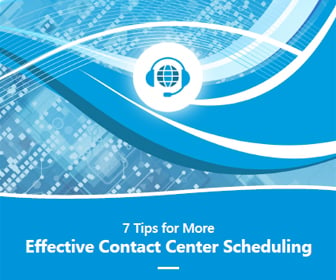Workforce Management Featured Article
Managing Shrinkage is a Critical Element of Accurate Call Center Scheduling
While the ability to put together a useful and accurate schedule is critical in the contact center, not all schedules are created equal. A schedule that looks great at 8:00 in the morning may be laughably useless by 10:00 am depending on a number of factors. These might include agents calling in sick, extended bathroom breaks, lateness back from breaks, meetings, training and countless other factors that can throw a schedule out of whack.
For this reason, the ability to operate in the real world and cope with schedule “shrinkage” is a critical one. If these unknown factors throw the schedule off too badly, they can cause long queues leading to long hold times that can damage customer relationships forever, and even cause customer churn.
So if the key is ensuring that the schedule can cope with whatever daily realities are thrown at it, how do you plan and compensate for these unknown factors? According to Stan Mack of Demand Media writing for the Houston Chronicle, it starts with determining your base staff requirements, or the number of workers you need on hand at different times of the day to handle typical call volume.
“For many call centers, call volumes vary widely throughout the day, so choose intervals that make sense for your business,” says Mack. “For example, you might need 100 workers to handle calls during the day but twice that number in the early evening as customers leave work and begin to attend to personal business.”

Next, managers need to estimate the typical percentage of workers who are unavailable to handle calls despite being scheduled to work, says Mack, noting that many call centers have shrinkage percentages of 10 to 40 percent.
“Just like your base staff requirements, shrinkage percentages vary, so you won’t find a magic number that perfectly predicts how many workers will go missing,” he writes. The goal here is to build a fairly reliable estimate that can work to minimize the chances of being short-staffed.
“When you feel comfortable with your shrinkage estimate, use the figure to schedule workers,” writes Mack. “Subtract the shrinkage percentage in decimal form from 1. Divide your base staff requirement by that result to arrive at the number of workers you should schedule. For example, if you know you need 100 workers on a given day, and typical shrinkage is 40 percent, the formula would be as follows: 100 divided by (1 minus 0.4), or roughly 167. This means if you schedule 167 people, but 40 percent can’t answer phones for various reasons, the remainder will be 100, which fulfills your base staffing requirements.”
While it may not be perfect, it’s a good rule of thumb for planning for shrinkage. Without the ability to make real-world determinations of scheduling and ensure that there are enough resources to avoid harming customer relationships, contact centers will frequently find themselves in trouble: operating simply to put out fires and not to do the intended work of the contact center: to cultivate customer relationships.







